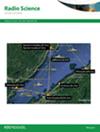Low latitude ionospheric irregularity observations across a wide frequency spectrum from VHF to S-band in the Indian longitudes
IF 1.6
4区 地球科学
Q3 ASTRONOMY & ASTROPHYSICS
引用次数: 0
Abstract
This study reports coordinated observation of ionospheric irregularities from VHF Radar, GPS and IRNSS (Indian Regional Navigation Satellite System), from regions near the northern crest of the EIA (Equatorial Ionization Anomaly), which has not been explored earlier. Efforts have been made to study the signal-in-space environment for concurrent detection of ionospheric irregularities over a range of radio frequency, starting from 53 MHz of the Radar, to L-band of GPS at 1,575.42 MHz and S band signal of IRNSS at 2,492.5 MHz. The radar is operational at Ionosphere Field Station, Haringhata (geographic latitude 22.93°N; geographic longitude 88.5I°E; magnetic dip angle 36.2°N) of University of Calcutta. The GPS and IRNSS data are recorded at Calcutta (22.58°N, 88.38°E geographic; magnetic dip: 36°N), separated from Haringhata by 50 km. The spatial as well as temporal variations of irregularities affecting different radio frequencies have been presented. Coordinated observations have been made during period of March-April 2023. Results of the study reveal the common zone of impact of the different radio frequency links spanning from 53 to 2,592.5 MHz and was identified within I6°–25°N, 85°–90°E. During coordinated observations made over several days, irregularity structures have been observed with radar, having backscatter SNR (Signal to Noise ratio) intensity within — 5 to 15 dB. During this time, while intense L band scintillation was recorded on multiple satellites of GPS, scintillation recorded at S band signal was moderate to intense.在印度经度地区从甚高频到 S 波段的宽频谱范围内进行低纬度电离层不规则性观测
本研究报告了从甚高频雷达、全球定位系统和 IRNSS(印度区域导航卫星系 统)对电离层不规则现象进行的协调观测,观测地点位于赤道电离异常北部峰顶 附近的区域,此前未对该区域进行过探索。已努力研究空间信号环境,以便同时探测从雷达 53 兆赫到全球定位系统 L 波段 1,575.42 兆赫和 IRNSS S 波段 2,492.5 兆赫的无线电频率范围内的电离层不规则情况。雷达在加尔各答大学哈林哈塔电离层场站(地理纬度 22.93°N;地理经度 88.5I°E;磁倾角 36.2°N)运行。全球定位系统和 IRNSS 数据记录在加尔各答(地理纬度 22.58°N,88.38°E;磁倾角 36°N),与哈林哈塔相距 50 公里。介绍了影响不同无线电频率的不规则现象的空间和时间变化。在 2023 年 3 月至 4 月期间进行了协调观测。研究结果表明,不同无线电频率链路的共同影响区跨越 53 至 2,592.5 兆赫,位于北纬 I6°-25°,东经 85°-90°。在几天的协调观测中,雷达观测到了不规则结构,其反向散射 SNR(信噪比)强度在 - 5 至 15 dB 之间。在此期间,虽然全球定位系统的多颗卫星记录到强烈的 L 波段闪烁,但 S 波段信号记录到的闪烁强度为中等至强烈。
本文章由计算机程序翻译,如有差异,请以英文原文为准。
求助全文
约1分钟内获得全文
求助全文
来源期刊

Radio Science
工程技术-地球化学与地球物理
CiteScore
3.30
自引率
12.50%
发文量
112
审稿时长
1 months
期刊介绍:
Radio Science (RDS) publishes original scientific contributions on radio-frequency electromagnetic-propagation and its applications. Contributions covering measurement, modelling, prediction and forecasting techniques pertinent to fields and waves - including antennas, signals and systems, the terrestrial and space environment and radio propagation problems in radio astronomy - are welcome. Contributions may address propagation through, interaction with, and remote sensing of structures, geophysical media, plasmas, and materials, as well as the application of radio frequency electromagnetic techniques to remote sensing of the Earth and other bodies in the solar system.
 求助内容:
求助内容: 应助结果提醒方式:
应助结果提醒方式:


